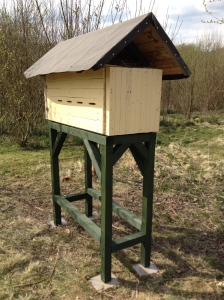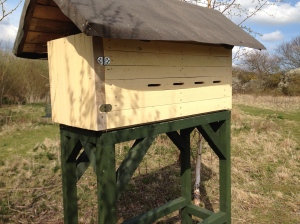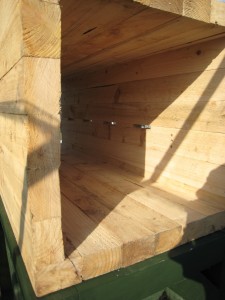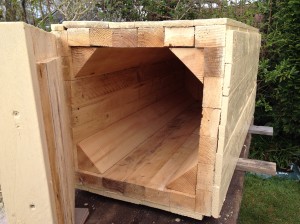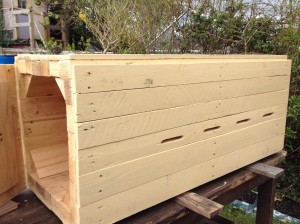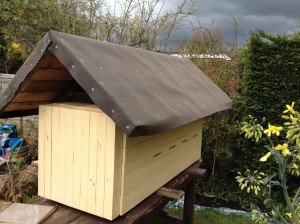Okay the beehive is now finished, it took me a while to get a hinge and catch, but now I have attached them to one end for a door. This is so I can remove a little honeycomb and leave the majority for the bees.
Leaving honey for the bees, yes it seems a strange idea for most beekeepers, but I feel that it is an important issue especially right now because bees are in the news a lot due to reports of declining populations based on disease, CCD, pesticides etc.
As well as letting bees keep most of their honey, maybe as a society we should start thinking about honey as the greatest health product ever – a golden elixir of life, rather than just something sweet to pour on toast. This would help us to appreciate how much a bee does to make honey and all so selflessly.
This type of hive is what I would maybe class a mansion/castle rather than the “flat” or “block of flats” conventional style of hive being used. In all honesty these kinds of hives have had a their time and they have worked for those that harvest honey from mass produced colonies where hundreds of hives work and have all their honey taken, to garden based set ups with 2 or 3 hives where beekeepers sell their jars on their driveways.
If more people had this form of hive instead of the conventional one we’d be taking a step in the right direction.
These conventional hives only started this way because the original creator – Mr Langstroth only had a wine crate to start with!
There are now so many other exciting types of hive in development (Einraumbeute, topbar, Warré) but you can’t beat a custom made where the walls are thick enough (thicker than most out there).
A hive like this would be ideal for the bees:
- Thicker wall – warmer and better insulated
- Larger size for greater expansion of the colony
- Undisturbed hive – no heat loss, scent loss
- Strong colonies would lead to more swarms, more swarms = more bees pollinating
- Cheap to make yourself, no constant outlay for wax frames etc
Dimensions
This homemade hive is 400mm x 400mm inside cavity size and the wall thickness needs to be 60mm and 1200mm in length. I used 2 sizes of wood to make it up to 65mm thick. The corners need a piece cut diagonally so when fitted inside the corners give a more rounded shape. I just used a little glue in the very middle (just so the bees can’t come into contact with the glue) and they will firm it up later themselves. And as you can see no screws penetrate into the hive.
The ends:
one end fixed/screwed with the other end opening with a hinge. This was made so the it fits into the opening – dry grasses will do for filling the gaps. A slit or series of slits were made along one edge no larger than 15mm high starting 300mm from the hinged end.
Then ideally when placing the hive it should face with the slit ends towards the south and be no lower than 250mm off the ground, it could also be at a 20-30 degree angle, with the opening end at the bottom.
Deciduous wood is the best kind of wood but I personally didn’t have any so I used old pallets and I think this is predominately pine. Okay so this is not my idea for a hive, it is something I have read about. I just thought I would pass on this information.
I had to get a company to supply and cut the inside diagonal lengths of timber. You don’t have to but I thought I would also paint the outside with a bee friendly paint from Ieko, this Osmo – Country Colour paint doesn’t contain biocides nor preservatives and is made from natural vegetable oils.
To help the bees get established in case you are now persuaded to get your own colony they love to start with some wax and some plant that produces nectar, just to have a sweet smelling attractive hive to entice them.
But be patient for the honey it takes time….

